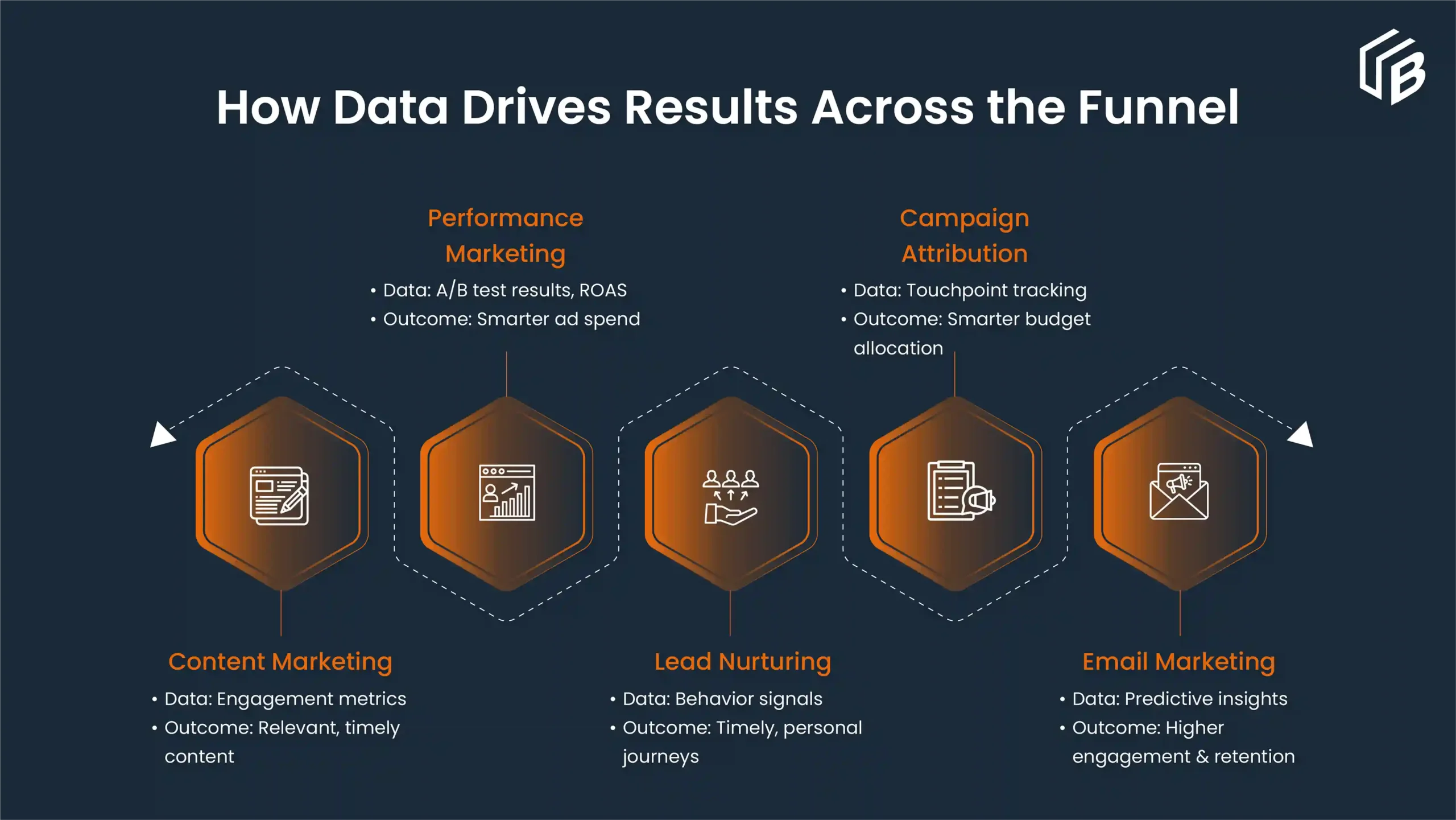
It’s well established that data drives better marketing decisions than guesswork. That’s why companies should consistently analyze customer behavior, track what’s working and what isn’t, and identify clear areas for improvement.
Here’s how it’s done:
- Study past campaign results to see what resonated with your audience.
- Monitor how users interact with your website and content.
- Combine insights from your CRM, ad platforms, and industry trends.
Every data point tells us something valuable. It indicates the new customer segment one should focus upon or may show that a particular message drives more conversions. With the right customer insight strategy, marketing managers and decision-makers can refine their approach in real time. This includes allocating budget more efficiently and personalizing outreach to drive better results.
The outcome?
- Marketing that actually performs
- Higher engagement
- More qualified leads
- Growth that’s driven by marketing teams, not just intuition.
The Hidden Roadblocks: Challenges of Data-Driven Customer Insight Strategy
In B2B marketing, the volume of data generated from campaigns, touchpoints, and tools is massive. Yet many organizations struggle to translate this into customer data-driven insights that are actionable. These are real operational and strategic roadblocks which apparently range from fragmented systems and outdated tools.
These obstacles raise concerns around privacy and compliance. It is must for marketers to address these challenges in order to prevent their falling short on impact delivering and making the most advanced data work.
Below, we explore two of the most pressing barriers: data overload and data privacy, along with practical steps to overcome them.
Challenge 1: Data Overload
With so many data sources available, the data environment becomes complex and leads to an overwhelming cacophony of the information. This is where CRM platforms, website analytics, intent data providers, and marketing automation tools become the saviors. These platforms and tools can help marketers to analyze all the data to decide the relevancy and the priorities. Here are some ways to overcome data overload for better data driven campaigns:
Key Strategies To Manage Data Overload:
1. Data Filtering and Segmentation
Break large datasets into smaller, focused segments like categorizing website visitor data by demographics, engagement level, or topic interests which in turn lead to customized messaging and better targeting across the channels.
2. Data Visualization
Spreadsheets alone can’t surface trends effectively. Visual tools like dashboards, charts, and heatmaps help teams quickly identify patterns and spot opportunities. These visuals make it easier for stakeholders across marketing and sales to act on the data.
3. Real-Time Monitoring and Alerts
Timely insight is often the difference between a missed opportunity and a conversion. Real-time analytics platforms can notify teams of performance shifts, behavioral changes and traffic fluctuations, allowing for immediate adjustments to campaigns, messaging, or offers.
4. Predictive Analytics
Using historical data to forecasts future trends can help marketing teams plan more strategically. For example, by analyzing past campaign performance and purchase behavior, a B2B tech company can forecast demand fluctuations and adjust go-to-market strategies accordingly.
5. Machine Learning Integration
As data evolves, so should your models. Machine learning enhances analytics tools by recognizing and adapting to new patterns over time. For instance, a B2B service provider, for instance, could use machine learning to continuously refine lead scoring models based on customer engagement signals.
Challenge 2: Data Privacy and Security
With increased reliance on data comes increased scrutiny. Regulatory frameworks like GDPR and CCPA are just the beginning—customers and stakeholders alike expect companies to handle data responsibly and transparently.
Steps To Strengthen Data Privacy In Marketing Operations:
1. Data Encryption
Encrypt sensitive information both in transit and at rest, particularly for customer contact details and behavioral data used in campaigns. This is essential for maintaining compliance and protecting customer trust.
2. Access Controls and Authentication
Implement role-based access controls (RBAC) across marketing systems to ensure only authorized personnel can view or manipulate customer data. Strengthen your systems with multi-factor authentication (MFA) to reduce the risk of breaches.
3. Regular Security Audits and Monitoring
Periodic audits and continuous system monitoring help identify vulnerabilities early. Monitoring tools can flag unusual activity, while audit trails provide accountability and insight into how data is accessed and used.
4. Employee Training and Awareness
The human element remains a top risk in data security. Equip marketing teams with regular training on identifying phishing attempts, managing passwords, and following data-handling protocols. Awareness is key to minimizing unintentional exposure.
5. Vendor Security Assessment
If your martech stack includes third-party tools, make sure those vendors uphold strong data protection practices. Conduct security assessments before onboarding, and review contracts regularly to ensure compliance with your organization’s standards.
What are the Top Examples of Data-Driven B2B Marketing?
Modern B2B marketing teams rely on data as their foundation, not just for reporting, but for refining strategies, optimizing execution, and driving faster, smarter results. If you utilize it efficiently, it can enhance data precision, relevance and impact across every stage of the marketing funnel.
Below are five key areas where data-driven B2B marketing is delivering meaningful outcomes:

1. Content Marketing that Hits the Mark
It is always said, great content starts with understanding your audience. Data-driven content marketing helps teams analyze trends, metrics, and customer behavior to guide what content to create, when to publish it, and which channels to leverage for promotion. Whether it’s blog posts, whitepapers, or LinkedIn updates, data helps ensure your content is relevant, timely, and aligned with your buyer’s journey.
2. Performance Marketing that’s Actually Accountable
Data is the foundation that performance marketing thrives on. From paid search to display ads and paid social, success depends on tracking key metrics like click-through rates, conversion rates, cost per acquisition, and return on ad spend. In such scenarios data becomes the aid for the marketers, as it allows them to A/B test creatives, optimize ad spend, and improve conversion rates by understanding which campaigns resonate, and which don’t.
3. Lead Nurturing that Feels Personal
Not every lead is ready to convert but data helps ensure the right message reaches the right contact at the right time. Behavioral data like email opens, site visits, and asset downloads inform automated nurture paths that move leads forward with relevance.
4. Campaign Marketing with Clear Attribution
Data brings clarity to multi-channel campaigns — but attribution is what ties it all together. With the right tracking in place, marketers can see how each touchpoint contributes to pipeline and revenue. This leaves a room for better budget decisions, sharper messaging, and continuous improvement across every campaign.
5. Email Marketing that Goes Beyond Opens and Clicks
Effective email marketing is powered by data. Beyond basic metrics, marketers now analyze subscriber behavior, segment performance, and predictive insights to craft emails that engage, convert, and retain customers.
From Insight to Impact: How to Implement a Data-Driven Customer Insight Strategy
Driving real marketing impact takes more than just data, it requires a strategy backed by disciplined workflows and systems. Together, these ensure the consistent production of high-quality, results-focused content that actually moves the needle.
The foundation of this effort begins with research followed by quality production alongside trend prediction. Your proper foundation allows you to develop memorable campaigns that will boost your brand and generate measurable business expansion.
Here are nine best practices to guide your data-driven content marketing strategy:
1. Start with the data
A thorough inspection of your existing sales and marketing data should be your first step. Ask yourself:
- What metrics are we tracking?
- How are they being captured?
- Where are the gaps?
Taking a clear view of what’s happening lets you develop solutions for improving weak areas while identifying fresh business possibilities.
2. Build a smarter content strategy
Make an in-depth examination of everything you already have published. What’s missing? What’s underperforming? What’s resonating?
Start by analyzing your direct competitors. The achievements and missteps of your competitors give you a valuable perspective on which content aspects need greater focus and which need reduction.
3. Align marketing with revenue
Every marketer should take personal responsibility for contributing to revenue goals. By aligning company objectives with clear assignments for teams and roles and backing them with measurable performance metrics, organizations can drive stronger accountability and improved results across the board.
Marketing must go beyond being a support function; high-performing teams lead strategic initiatives and operate in lockstep with business goals. To truly influence growth, marketing should own key metrics and consistently demonstrate its direct impact on revenue.
4. Become a product expert
The best B2B marketers deeply understand what they’re selling.
Build strong relationships with your product and sales teams. Organize regular training sessions and keep the conversations going. Product fluency makes your messaging sharper and your content far more effective.
5. Take a structured approach to paid media
Begin your PPC and paid marketing initiatives with minimal investment. After deploying testing initiatives, focus on optimization through a continuous assessment of subpar components that should be terminated.
A data-driven approach requires both bold experimentation and rapid discipline when making adjustments.
6. Audit your tech stack
Technology changes fast. You must routinely assess if your existing tools enhance your performance levels or impede it.
A non-valuable tool should be replaced with a better version when it offers increased ROI potential or smarter scalability.
7. Nurture demand, not just leads
Lead nurturing isn’t just about the end result, it’s about every step in the journey.
Measure each stage of your email workflows, adjust in real time, and optimize for sustained engagement. Data-powered demand generation is where great marketing happens.
8. Ship fast, learn faster
Execution creates data. So don’t wait for perfection, launch campaigns, gather insights, and iterate often.
Every asset you publish becomes a learning opportunity. The faster you move, the faster you improve.
Creativity might get attention, but data drives performance. The more disciplined you are with your data-driven approach, the bigger the impact you’ll make. Now go make it happen.
Conclusion
In B2B marketing, the brands that win aren’t just the ones with the most data, they’re the ones who know how to use it. A well-built customer insights strategy helps you cut through the noise, understand what really matters to your buyers, and act with clarity and confidence. It’s how you move from guesswork to strategy, from generic to relevant. And ultimately, it’s how you create marketing that drives real results. Now’s the time to turn those insights into impact.
Our blog
Latest blog posts
Tool and strategies modern teams need to help their companies grow.

The 95/5 rule in B2B marketing shows that while only 5% of buyers are ready to purcha...

Running a business comes with its own set of challenges, especially when it comes to ...

AI is surely a futuristic concept but it evolves today, particularly in sales and mar...








